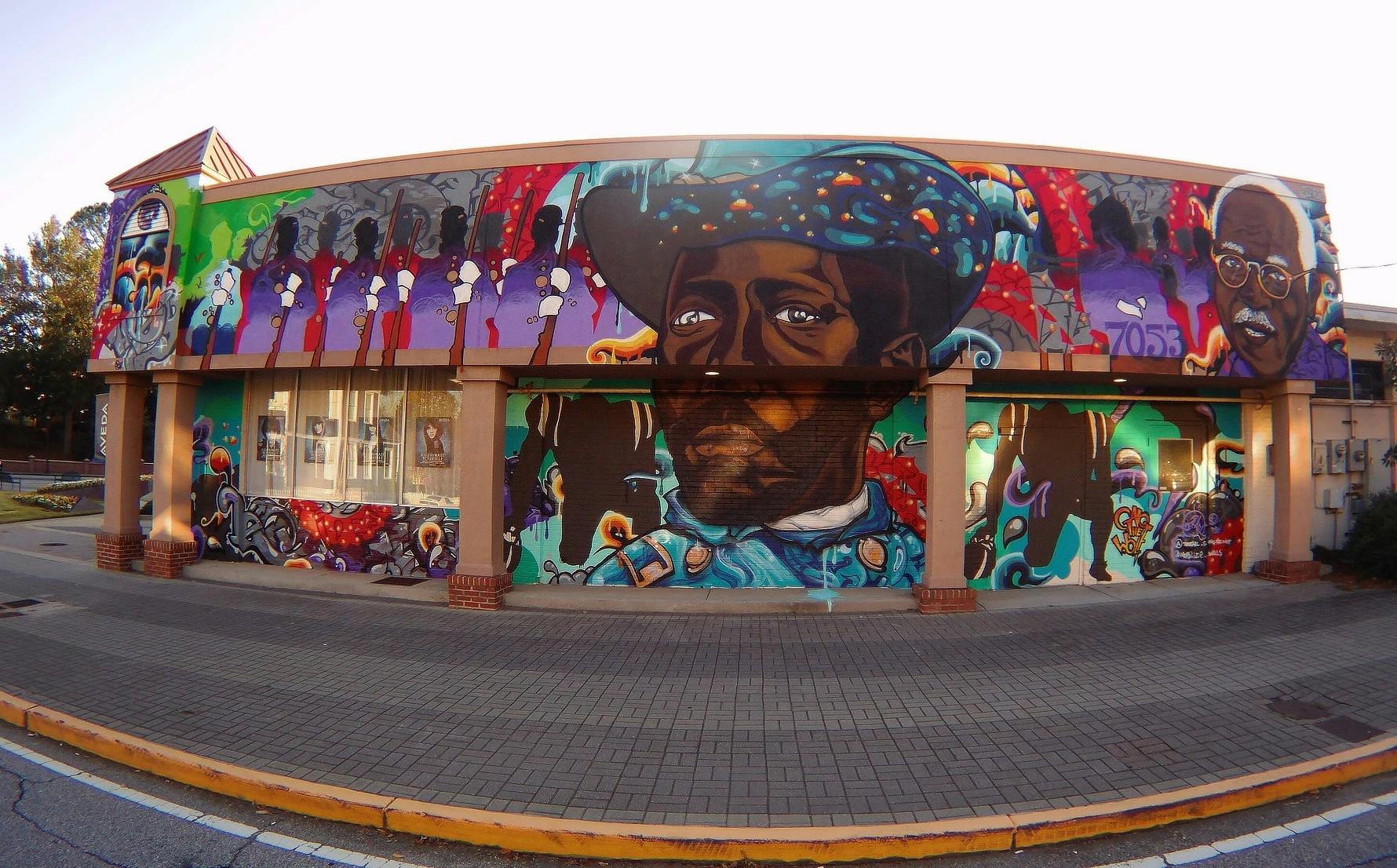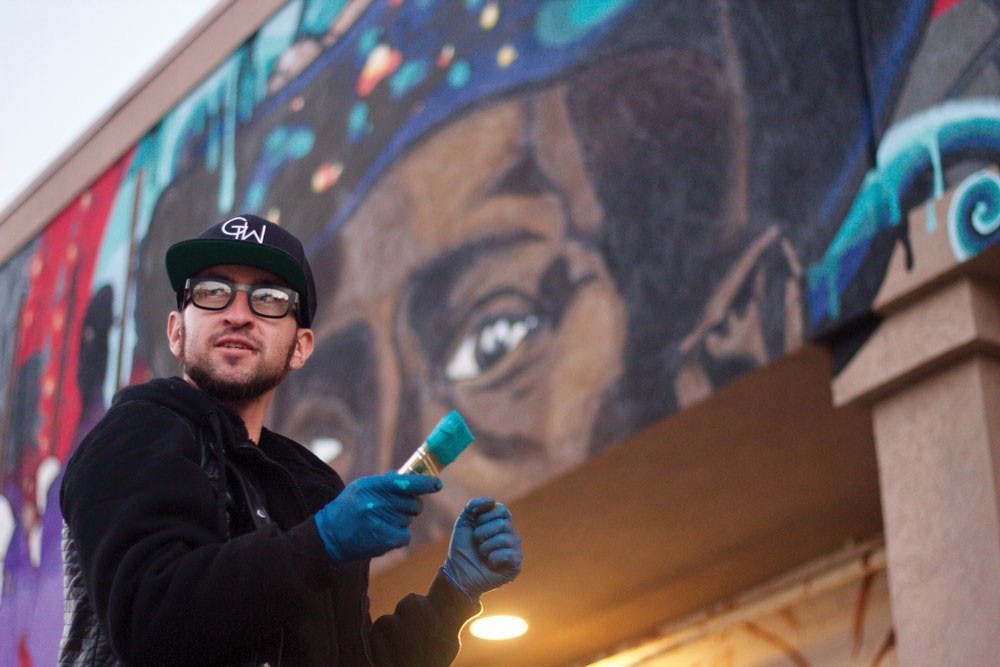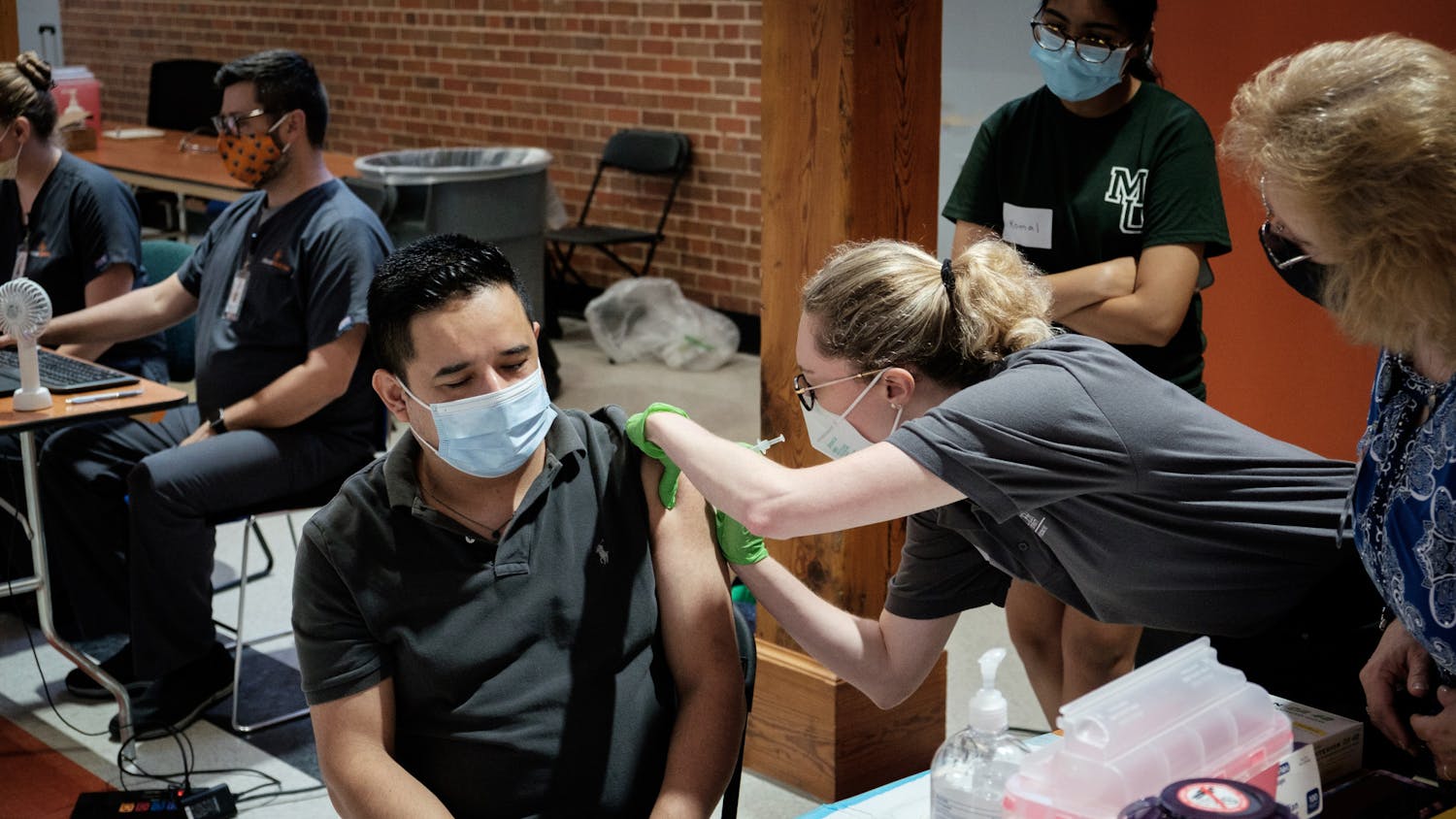Nearly two years ago, the Mercer and Macon communities stood astonished when the university painted over a mural honoring Black history and advocacy after students had just been sent home due to the COVID-19 pandemic.
The mural was titled “Cultivating New Tones On The Spectral Stage Of History” and painted by artist Joerael Numina. Vibrant with bright reds, purples, blues and greens, the piece was unceremoniously covered with stark, industrial white.
The university provided a succinct statement to local TV station 13WMAZ upon the mural’s removal: “Mercer Village mural was commissioned and funded by the College Hill Corridor Commission several years ago as a ‘pop-up’ public art demonstration project. It was never intended to be permanent.”
That, however, never seemed to be the full story. The Cluster previously reported that the mural was funded by the College Hill Art Alliance, Art in the Park and Mercer’s women’s and gender studies and art departments with funding from The Knight Foundation. Allegedly, none of these groups were told that the painting would be removed.
“All the departments’ funding went toward this, and they were all contributing for this mural to happen as a permanent installation,” Numina said to The Cluster in April 2020. “Personally, I wouldn’t have come and painted something with that type of content if it was a temporary mural.”
Quickly approaching two years since the mural’s removal, it is still unclear why the mural was removed, if any retributions were made to the artist or the community, and if there will ever be a mural on the previously occupied wall ever again.
How Joerael came to Mercer

Numina was originally brought to Mercer’s campus all the way from Santa Fe, New Mexico by his friend, Natalie Bourdon, a women’s and gender studies and anthropology professor at the university. The two had met at a Sante Fe yoga temple where Bourdon was training to become an instructor. Over the next few years, she had conversations with Art Department Chair Craig Coleman about him.
“I know Craig always brings in artists. I said, ‘This will be a really cool guy to bring in as an artist,’” Bourdon said. “We don't really have a lot of discussions about street art or graffiti murals, and I think he brings an interesting perspective to his work because a lot of his stuff is social-justice-oriented.”

Numina has his artistic roots in graffiti and street art. He was inspired by seeing the fall of the Berlin Wall in 1989, which was covered in street art and graffiti. In 1994, he started doing graffiti.
“The spirit of it is it’s one of the most inclusive types of art form there is, you know, like, anybody can do it,” he said.
In 2017, multiple groups came together to get Numina to bring his art to Mercer. The mural was primarily funded by The Knight Foundation, which invests in journalism, arts and culture in cities across the country.
“Craig went around with palms up,” Bourdon said.
What Joerael gave to Mercer

Artist Joerael Numina paints a mural on the exterior wall of Indigo Salon on Coleman Avenue in 2017. The mural is named “Cultivating New Tones on the Spectral Stage of History.”
Once Numina got on campus, he spent two weeks not only working on the mural in Mercer village but also teaching workshops and giving lectures.
“We didn't expect him to actually offer Mercer so much of his labor and his time and his energy,” Bourdon said. “In the evenings would mostly be over there, working on (the mural).”
In addition to the two weeks spent in Macon, Numina also spent weeks researching the history and culture of the area while planning the content for the mural. Needless to say, he kept himself busy once he arrived.
Aside from conferring with Bourdon and Coleman ahead of time, the ball was almost entirely in Numina’s court when it came to planning the content of the mural.
While working on the mural, he frequently asked passersby their advice on what he should include in the piece. This is how, for example, Rosa Parks ended up on the mural.
“Somebody in the neighborhood had stopped by when he was painting and said, ‘Why isn't any women on that mural?’ And he was just like, ‘Oh, of course! Who would you like to see?’ and she said Rosa Parks, and he put her in there,” Bourdon said. “I feel like he approaches his work in a very collaborative way.”
Numina also interviewed multiple members of the Mercer community before he began painting, including Black female athletes.
Once he started, people would drive by and cheer for him as he painted.
“People from Macon love it,” he said. “And I remember some people, saying, ‘I never thought I would see something like this here.’ So I knew I was doing something good.”
The mural, inspired by Black history, the failure to remove Confederate statues and the Black Lives Matter movement, ended up containing figures such as Sam Oni, a Ghanan missionary convert who became the first black student to attend Mercer in 1963. The mural also featured athletes kneeling, inspired by Colin Rand Kaepernick kneeling during the national anthem, Martin Delany, a 19th-century doctor and the first African American field grade officer in the U.S. Army, as well as Rosa Parks and Black Civil War soldiers.
Numina was interested in the concept of how people use their bodies in acts of protest. For instance, when Sam Oni was before a congregation in Georgia and the minister had them vote on his membership by having them raise their hands in favor or opposition. The congregation slimly voted in favor of Oni’s membership.
“It was this moment where he saw who stood and who sat down. Those people were taking an active role using their bodies in that moment to show up for Sam,” Numina said. “Martin Delaney did that. In many ways, the Black Civil War soldiers did that. Rosa Parks did that. Athletes have been doing it.”
The mural was completed Nov. 17, 2017 and was unveiled to about a dozen spectators.
The mural’s removal
On the morning of April 28, 2020, Mercer painted over Numina’s mural with no prior notice or reasoning provided. The painters were discrete, and the Mercer community probably would not have noticed as quickly if it weren’t for news coverage and social media posts.
Upon its removal, Numina and his legal team released a statement.
“As required by law, Mercer did not provide Numina legal notice of its decision to paint over this extraordinary mural, which would have allowed him the ability to stop the destruction of his art,” the release stated.
The law in question is the Visual Artist Rights Act of 1990, which grants artists rights relating to their work. It states that artists have the right to “to prevent any destruction of a work of recognized stature.”
To this day, Mercer has not commented on why the mural was removed; they did, however, provide a brief statement saying the mural was never intended to be permanent.
According to The Macon Telegraph, one Mercer student wrote an email to university President Bill Underwood about how he was disappointed that the mural was removed. Underwood replied that the “Memory of (the people depicted in the mural’s) legacy and contributions is hardly dependent on the mural that I allowed to be painted in Mercer Village as part of a class demonstration on street art.”
“My expectation was, and continues to be, to allow that space to be utilized by other artists, including student artists, in the years ahead. I am hopeful that future artworks featured there will make important contributions to campus and to the surrounding community,” Underwood said in his email to the student.
In his press release, Numina said he intended to pursue legal action against Mercer “to the full extent of the law, including but not limited to the federal Artist Rights Act.”
“Numina believes this signals the marginalization of communities and diminishing empowerment,” the release states. “It is hypocrisy at best, especially in light of Georgia’s laws against the removal or alteration of memorials depicting Confederate soldiers from a bygone era.”
What comes next?
Since the mural was painted over, no other art has taken its place like Underwood said his expectation was. The university told The Cluster that there are no current plans with the space that was painted over.
Both Numina and Mercer University declined to comment regarding the removal of the mural or any current litigation. No court action has been filed.
Bourdon said that she is still shocked at Mercer’s response.
“I think it's still disturbing to me that nothing has gone up at that space. That, especially after summer 2020, the administration didn't reflect and say they're sorry for removing it, for whitewashing over a mural dedicated to Black history,” she said.
Despite the removal of his mural, however, Numina says he is not opposed to returning to Macon to work on more murals. Although, he does ask that first, commissioners consider Indigenous, BIPOC and female artists.
“If someone's going to give me a wall and invites me, which I will gladly receive and take it because I have to survive, and I love to create, and I also love to speak up when I can or have that opportunity, (then) I will do my best to do it the right way and I'll show up to do it,” he said.
There is no real end to this story. No public resolution has been made, and members of the Mercer community still talk about the mural’s removal with disdain. All the community has left is the hope that one day there will be another mural to take its place, one that has the promise of being more permanent and has the same impact as Joerael’s.
This piece was originally written for a final project for ART 373: Picturing Gender. Hall focused on finding new information about the removed mural for her assignment.
Corrections: This article formerly stated that the mural was inspired in part by Black Confederate soldiers. Numina said the piece included Black Civil War soldiers without specifying for which side they were fighting — this article has been updated to correct this.
Mary Helene Hall ‘23 is a journalism and women’s and gender studies student who has worked for The Cluster throughout her time at Mercer. She has held internships at The Atlanta Journal-Constitution and AL.com, where she covered a variety of topics including politics, crime and culture.





